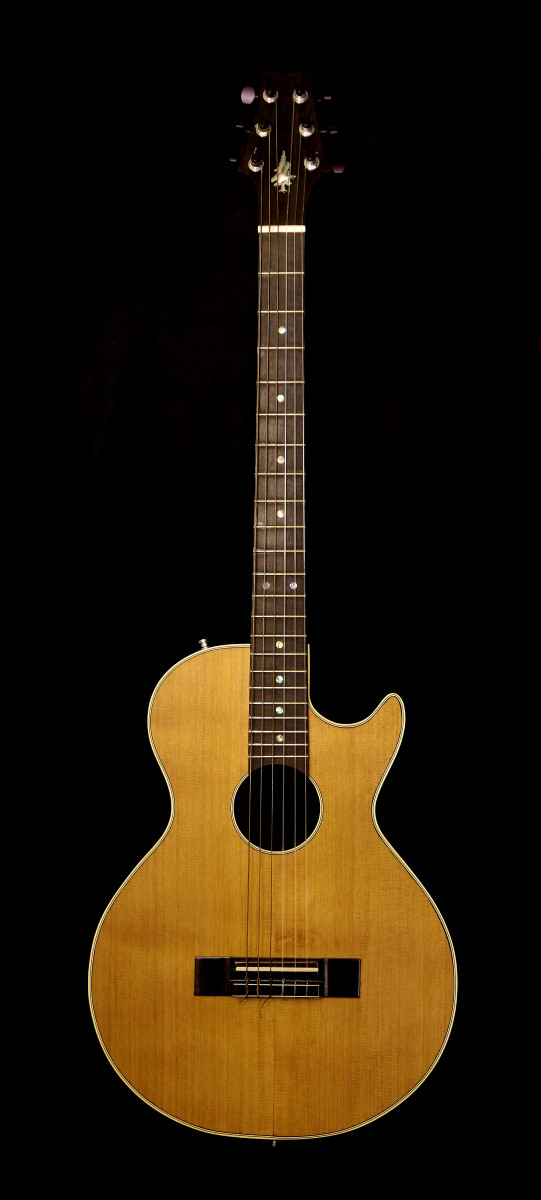

Don’t Sue me, Bro
Early 2009
This is so obviously not a product of Gibson. And so much less than a Les Paul.
Jimmy Page would not have a whole lotta love for this guitar. This guitar would make Slash cry “wah wah” if it were a sweet child o’ his. This is a nylon string electric, and it doesn’t really rock.
Nylon strings are the modern replacement for what would have traditionally been gut string, but less gross. Generalizations are difficult, but in the guitar world, nylon strings are most commonly associated with things like classical, flamenco, bossa nova, and Willie Nelson. They’re under less tension than steel strings, so they feel and sound different, with nylon strings generally considered more mellow.
The solid body nylon string guitar is a pretty niche instrument, and there aren’t many of them out there. I don’t know much about classical guitar, but my sense is that, like orchestral violinists, classical players run pretty conservative in their instrument tastes. In the same way that this guitar would not be confused for the iconic rock guitar from which its name is parodied, it would also never be confused with a Torres. That’s the joke.
The other Joke
On an acoustic guitar, when the strings are played, they vibrate the saddle, which vibrates the bridge, which vibrates the top, which causes the air inside the body to vibrate, and some of those vibrations exit through the sound hole. That makes the whole system louder, and the sound is developed—it sounds different from the strings vibrating in isolation.
But the Less Paul isn’t an acoustic guitar…it’s a solid body electric. The strings vibrate the saddle, which vibrates a piezo pickup that converts the physical vibrations into an electrical signal.
So the sound hole has no acoustic properties, and in fact, goes all the way through the body.

Construction
This was the first guitar that I made completely from scratch. It has a solid mahogany body with a cedar top. The mahogany was slightly weight-relieved before the top was glued on by drilling holes into it (but not through it, like the fake sound hole) with a large forstner bit. The neck is also mahogany with an ebony fretboard and peghead overlay. The bridge is ebony, and the process of machining it almost killed my Dremel. I wound up making most of it with chisels, which I initially thought would be impossible, but turned out to be quite pleasant. The body and sound hole are bound with ivoroid binding and black/white/black purfling, and the fret marker dots and peghead inlay are abalone.
I had a hard time sourcing tuning machines for this. Nylon strings stretch a lot, and their tuners have a much larger tuning post than the ones for steel strings, but most of them are for slotted headstocks. Sadowsky Guitars makes a similar guitar, so I called them and they sent me to Sperzel. I may have actually talked to Roger Sadowsky, in which case I am only two degrees of separation from Steely Dan.
There’s an undersaddle piezo pickup. A piezo element puts out an extremely high impedance output that will barely make it down a length of cable. Most production acoustic-electric guitars have a built in preamp that boosts the signal and converts it to low impedance so that it can be run to the mixer or amplifier or whatever. I hate dealing with batteries in instruments though (which would be required for an active preamp), so this is a completely passive setup and needs a short cable run to an external preamp.
Sound
Piezo elements are not known for the most faithful or pleasant sound reproduction, but it still sounds surprisingly like a nylon string. At least until you start running it into an electric guitar amp. And then add a Tube Screamer.















